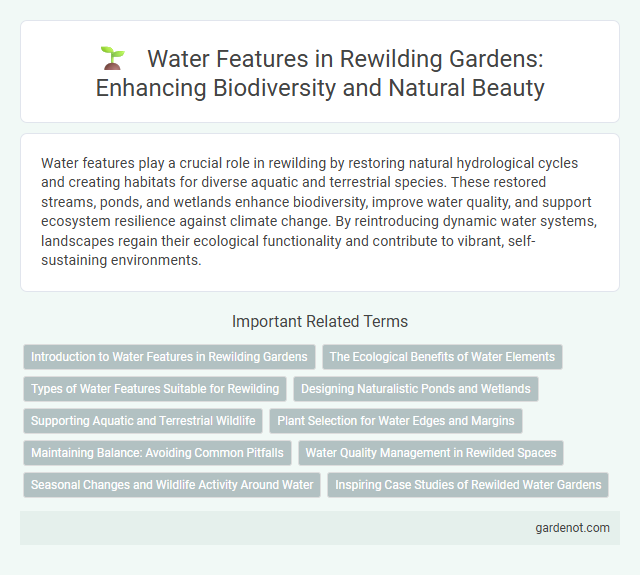Water features play a crucial role in rewilding by restoring natural hydrological cycles and creating habitats for diverse aquatic and terrestrial species. These restored streams, ponds, and wetlands enhance biodiversity, improve water quality, and support ecosystem resilience against climate change. By reintroducing dynamic water systems, landscapes regain their ecological functionality and contribute to vibrant, self-sustaining environments.
Introduction to Water Features in Rewilding Gardens
Water features in rewilding gardens serve as vital habitats for aquatic and semi-aquatic species, enhancing biodiversity and supporting ecosystem resilience. Natural ponds, streams, and wetlands mimic native hydrological conditions, promoting the return of amphibians, insects, and birds. Integrating these elements helps restore natural water cycles, improves water quality, and fosters a balanced, self-sustaining environment.
The Ecological Benefits of Water Elements
Water elements in rewilding projects create essential habitats supporting biodiversity by providing drinking water and breeding grounds for amphibians, insects, and birds. These features enhance local microclimates and improve soil moisture retention, promoting plant growth and stabilizing ecosystems. By facilitating nutrient cycling and sediment capture, water features contribute to healthier aquatic and terrestrial connections within restored landscapes.
Types of Water Features Suitable for Rewilding
Natural ponds, slow-moving streams, and wetland marshes serve as ideal water features for rewilding projects by providing essential habitats for diverse flora and fauna. These water bodies support amphibians, aquatic insects, and bird species, enhancing biodiversity and ecosystem resilience. Incorporating native aquatic plants like reeds and water lilies further stabilizes the environment and improves water quality.
Designing Naturalistic Ponds and Wetlands
Designing naturalistic ponds and wetlands involves creating diverse habitats that support native flora and fauna, enhancing biodiversity through carefully contoured shorelines and varying water depths. Incorporating native aquatic plants and natural filtration systems promotes water quality and provides shelter for amphibians, insects, and birds. These water features mimic natural ecosystems, fostering ecological balance and resilience in rewilded landscapes.
Supporting Aquatic and Terrestrial Wildlife
Water features designed for rewilding create vital habitats that support both aquatic and terrestrial wildlife by providing clean water, shelter, and breeding grounds. These features foster biodiversity by attracting amphibians, insects, birds, and mammals, which rely on water sources for survival and reproduction. Integrating native plants around ponds and streams enhances habitat complexity, promoting ecological balance and resilience.
Plant Selection for Water Edges and Margins
Selecting native, water-tolerant plants such as sedges (Carex spp.), rushes (Juncus spp.), and water lilies (Nymphaea spp.) enhances biodiversity and stabilizes banks in rewilding water edges and margins. These species provide critical habitat for amphibians, insects, and birds while improving water quality through natural filtration processes. Incorporating a mix of emergent, floating, and submerged vegetation supports a balanced aquatic ecosystem and promotes resilience against erosion.
Maintaining Balance: Avoiding Common Pitfalls
Maintaining balance in water features during rewilding projects involves careful management of nutrient levels to prevent eutrophication and algal blooms, which can disrupt aquatic ecosystems. Ensuring natural water flow and diversity of habitats supports species variety while avoiding stagnation and invasive species dominance. Regular monitoring and adaptive management help sustain ecological integrity and promote resilience in restored wetland environments.
Water Quality Management in Rewilded Spaces
Water quality management in rewilded spaces emphasizes natural filtration processes using native vegetation and wetland restoration to reduce pollutants and enhance biodiversity. Reintroducing beavers and other keystone species helps create dynamic water systems that improve oxygen levels and sediment balance. Continuous monitoring of nutrient loads, pH, and microbial activity supports maintaining ecological health and resilience in these restored habitats.
Seasonal Changes and Wildlife Activity Around Water
Seasonal changes in water features create dynamic habitats that support diverse wildlife activity throughout the year. During wet seasons, temporary pools attract amphibians and migratory birds, while dry periods encourage mammals and reptiles to congregate around shrinking water sources. These fluctuations enhance biodiversity by providing varied resources and breeding sites crucial for ecosystem rewilding.
Inspiring Case Studies of Rewilded Water Gardens
Rewilded water gardens, such as the Thames River rewilding project in London, showcase how natural aquatic habitats restore biodiversity by reintroducing native plants and creating habitats for amphibians and insects. The Knepp Estate in West Sussex integrates ponds and streams to support wetland species, demonstrating increased populations of dragonflies and water voles. These inspiring case studies highlight the ecological benefits of rewilding water features in urban and rural landscapes.
Water feature Infographic

 gardenot.com
gardenot.com